

To process the roots, which had been soaked or "retted" for a week or so, I removed the outer bark by pulling them through a V-shaped notch in a plank of wood, although I've also used a split branch with similar success. Once all bark is removed, carefully split the roots in half lengthwise. Control the evenness of the split by pulling the thicker half away at a more radical angle to "center" the split. Again, practice makes perfect. A second splitting may be required to obtain the desired thinness.
Once you've obtained some nice lengths of processed root (or commercial caning), about 1/8 inch wide and a couple of feet long, you're ready to sew up your basket. Begin by trimming each end of the sewing piece so that it acts as its own "needle", allowing easier insertion into the holes punched in the bark. Start your sewing toward the bottom where the halves of the side seam comes together, but not too deep into the basket where it's difficult to fit your hand inside.


Although a number of stitching techniques will work, I used a simple "X" lacing pattern, much like ordinary shoe-lacing. Pull the first stitch through from the inside until both ends stick out with equal length. A needle-nosed plier is helpful in grabbing the sewing material ends. Once the lacing reaches the top, hold the loose ends to the rim using another clothespin.
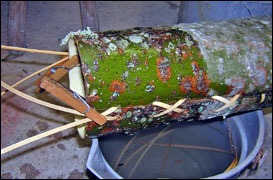
Now you'll need to find some suitable material for a rim reinforcement. I used bush dogwood (Cornus sp.) for my rim, but hazelnut, maple, and numerous other hardwood shoots will work just fine.
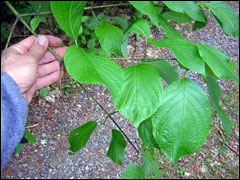
Look for a nice, evenly straight shoot about the diameter of your index finger. By using a string to measure the opening circumference, you'll get an idea of how long to cut your shoot (cut it longert to be safe!). After removing the bark, split the shoot lengthwise, yielding both an inner and outer rim piece. Each half may need additional thinning to allow it to bend to the contours of the opening. Cut a thinning taper into one end of one of the pieces, and clothespin-clip it to the inside of the basket rim. Carefully bend and work it around the inside circumference, clipping as you go. Taper the remaining end so it blends with the starting end, and clip together. The rounded surface of the stem should be facing towards the inside of the basket. Next, repeat the process with the other shoot-half on the outside circumference, clipping it down as you go.
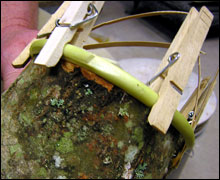

Take a long length of sewing material (root, etc.) and start whip-stitching the rim to the basket, beginning as shown in the photo below.
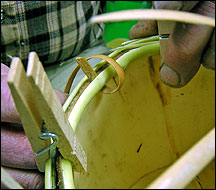
Punch each stitching hole just beneath the rim-shoots with your awl before every stitch. Squeeze the rim tightly together as you go and your result will be a nice, tightly reinforced rim.
To make a handle, we split out a nice piece of black ash, a wood whose splints have long been used for basket making in the eastern United States.
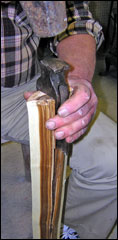
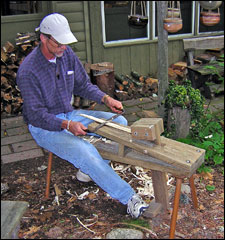

This handle piece was further thinned and shaped using a draw-knife and a shaving horse, or schnitzel-bank (see the article on how to make one of these amazingly handy work-benches on the PrimitiveWays homepage!). Carefully bend the handle into an arc, thin the ends a bit, and insert them into the reinforced rim at opposite sides. We used a small tack to secure the ends.

E-mail your comments to "Ken Peek" at kspeek123@att.net
We hope the information on the PrimitiveWays website is both instructional and enjoyable. Understand that no warranty or guarantee is included. We expect adults to act responsibly and children to be supervised by a responsible adult. If you use the information on this site to create your own projects or if you try techniques described on PrimitiveWays, behave in accordance with applicable laws, and think about the sustainability of natural resources. Using tools or techniques described on PrimitiveWays can be dangerous with exposure to heavy, sharp or pointed objects, fire, stone tools and hazards present in outdoor settings. Without proper care and caution, or if done incorrectly, there is a risk of property damage, personal injury or even death. So, be advised: Anyone using any information provided on the PrimitiveWays website assumes responsibility for using proper care and caution to protect property, the life, health and safety of himself or herself and all others. He or she expressly assumes all risk of harm or damage to all persons or property proximately caused by the use of this information.
© PrimitiveWays 2014